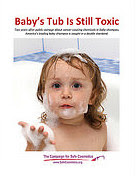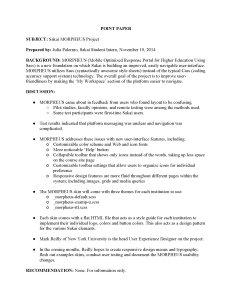Facebook members are currently sharing posts like this one, above, from July 31, which claim that baby shampoo and other cosmetic products manufactured by Johnson and Johnson contain cancer-causing chemicals “that may poison your baby.”
The embedded article from healthy-holistic-living.com (with no publication date) seems to report breaking news, which claims that Johnson and Johnson baby shampoo and other personal care products currently contain chemicals that are hazardous to human health.
Facebook members are sharing the news to warn others. Comments seem to indicate that many are tossing out their Johnson and Johnson shampoo and heading to the store to buy another brand.
Now, any responsible parent, relative, or citizen should be concerned about such reports, given the many examples of labels that hide or misrepresent unhealthy ingredients in products that we consume or put on our bodies. And words like “poison” in a headline and touching photos of a baby taking a bath will be sure to heighten concern.
In this case, however, consumers should focus their attention on the way that the content of the article – rather than the product label – is hiding or misrepresenting the facts. In fact, the article being shared across Facebook this week was originally published by Dr. Joseph Mercola on his popular health information Web site, mercola.com, on November 14, 2011 -- yes, nearly four years ago!
At first glance, Mercola's article, "Are You Using This Popular But Cancer-Causing Johnson & Johnson Shampoo?" looks like a legitimate account written by a medical expert and best-selling author. However, although his account may be accurate, Dr. Mercola's credibility may not be. Mercola has been accused by other medical doctors and watchdog sites like quackwatch.org of marketing controversial dietary supplements on his popular health information site.
According to Dr. Stephen Barrett in a September 2, 1014, Quackwatch report,
Many of Mercola's articles make unsubstantiated claims and clash with those of leading medical and public health organizations.”Dr. Barrett also reported that the U.S. Food and Drug Administration ordered Dr. Mercola in 2005 to stop making false claims about products sold on his Web site.

The Mercola article reported information that was then cited or repeated verbatim in subsequent articles. This information came from an original report issued by the Campaign for Safe Cosmetic Products, issued in November 2011, which led the initial charge about toxic ingredients in Johnson and Johnson products. Click the cover page, titled "Baby's Tub Is Still Toxic," to read the report.
According to the Campaign for Safe Cosmetic Products, Johnson and Johnson responded almost immediately and pledged a campaign to phase out all harmful products. Read this copy of the Campaign for Safe Cosmetics’s November 16, 2011, press release about Johnson and Johnson’s response.
Over the years, other organizations, like healthy-holistic-living and change.org have reprinted Dr. Mercola’s November 14, 2011, article word-for-word without attribution or citing the original date of the article. This makes a four-year-old story written by an author with questionable credibility look like current news with timely and accurate information.
In fact, the article is far from timely or accurate. In response to consumer concerns, Johnson and Johnson removed the widely reported chemicals quaternium-15 (a formaldehyde-producing chemical) and another chemical, 1,4 dioxane, over a year ago. The company is also on track to fulfill its pledge to complete a reformulation of its shampoos and other products this year, to ensure consumer safety.
The New York Times reported on Johnson and Johnson’s progress in an article on January 17, 2014:
What’s different about the shampoo, and 100 other baby products sold by Johnson & Johnson, isn’t so much about what’s been added; it’s what’s missing. The products no longer contain two potentially harmful chemicals, formaldehyde and 1,4-dioxane, that have come under increasing scrutiny by consumers and environmental groups.You can find additional facts about Johnson and Johnson's product reformulation and timeline on the company's "Reformulation for Trust" campaign Web site.
The rumor-busting snopes.com also reported on this issue in a post titled, “How Misplaced Fear of Formaldehyde Remade Johnson & Johnson’s Baby Shampoo.” The author of the post shared a link to an article published on March 2014 by health and science journalist Tara Haelle on slate.com.
In the article, Haelle warned consumers to be concerned about the ways that misleading, inaccurate, or even false reports can spread across social media like a virus, inflicting more widespread damage on consumer confidence and on companies who make consumer products.
The damage done to consumer confidence in products is as real and dangerous as that done by harmful consumer products to public health. And the motives behind such inaccurate and damaging articles can range from sloppy writing to unethical and even illegal (defamatory) attacks by commercial competitors or extremists who want consumers to stop buying a company’s products.
According to Haelle, “Once fear is established, it’s hard to overcome.” Quoting University of Texas health literacy professor Mike Mackert, she also pointed out,
Once people latch onto a particular belief, sometimes hearing contradictory, though correct, information only strengthens an incorrect belief.Haelle went on to explain that many advocacy groups and news reports also fail to explain the exact dosage of ingredients in personal care products or the exact nature of risks, choosing instead to sensationalize a story. In the case of quaternium-15, Haelle observed that the same levels of formaldehyde that were once found in the Johnson and Johnson shampoo are comparable to levels "when in the air and our food, and our exposures are so tiny as to be harmless.”
In the conclusion of the article, Haelle once again quoted Professor Mackert, as she pointed out the powerful, harmful, and deeply-entrenched effects of incorrect information on people’s belief systems:
Once people latch onto a particular belief, sometimes hearing contradictory, though correct, information only strengthens an incorrect belief.So, without minimizing the threats posed by harmful consumer products and the need for consumers to improve their health literacy, isn’t it about time we became concerned about harmful news reports and the need to improve our media literacy?






